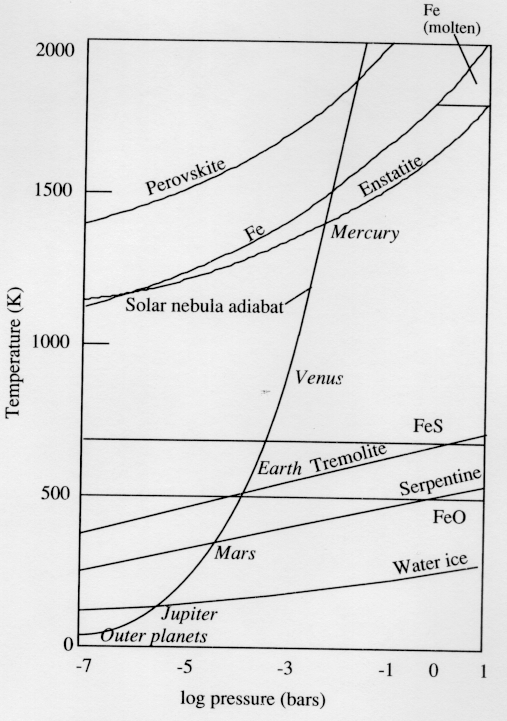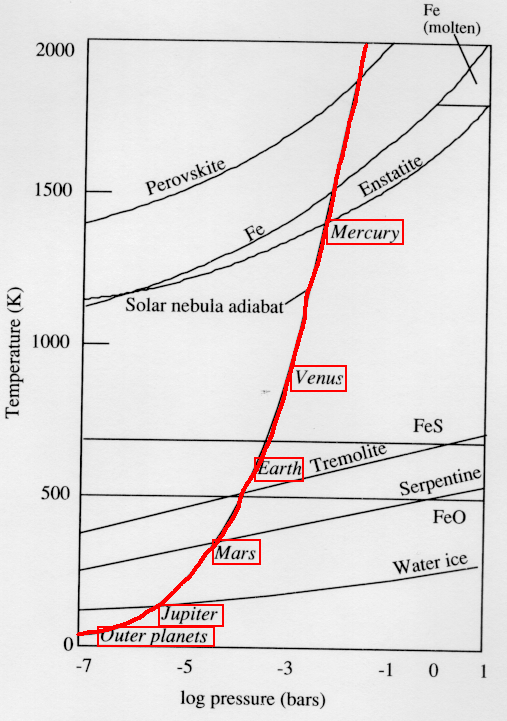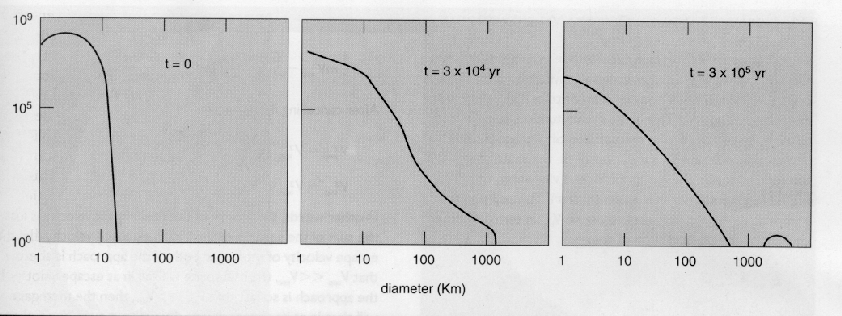Condensation: as a gaseous material cools, it will condense into solid or liquid form.
The solar nebula is a cooling gas. We can calculate what materials will condense out as the nebula cools. Here is an example of such a calculation.

| Given a temperature and pressure in
a region of
the solar nebula, we can ask what materials are likely to be found in
solid
form -- these will be the beginning of the planet-forming chunks.
Condensation: as a gaseous material cools, it will condense into solid or liquid form. The solar nebula is a cooling gas. We can calculate what materials will condense out as the nebula cools. Here is an example of such a calculation. |
 |
At the highest temperatures (>1500 K), we get refractory elements - elements which stay solid at high temperatures (tungsten, for example). We also get oxides of calcium, aluminum, and titanium (like perovskite, found in meteorites).
At about 1300K, we get nickle-iron alloys and magnesium-silicate minerals such as enstatite. These elements are more abundant than the refractories, so these dominated the hotter portions of the solar nebula.
At lower temperatures (400-500 K), hydrated minerals such as tremolite and serpentine can form, in which OH molecules can be incorporated -- these minerals can bind up water.
Water ice can form around 200 K; methane ice forms at 50 K. These ices are composed of very common elements (H, O, C, N) so that they dominate over the rocky material, and we have "dirty ice."
| Well, let's calculate the range of
pressure and
temperature in the early solar system, and mark where the planets fall
on this diagram.
We get a pretty fair match to the gross composition of the planets. Things to consider:
|
 |
We are now left with a disk of small grains with a
chemical
composition that varies with distance from the Sun. How do we go from
that
to planets?
A number of things can build up planetesimals - the seeds for growing planets:
1. Collisions of dust grains
Grain particles aggregated into fluffy clumps of dust (interplanetary dust bunnies?) which grew in mass through continual accretion.2. Electrostatic binding (Van der Waals forces)
Dust grains typically have electric charge, and can bond together by electrostatic forces and grow even faster.3. Gravitational attraction
In this disk of dust and gas, overdense regions will collapse due to gravity, collisions happen faster, and seeds grow even faster (similar to a Jeans collapse).These processes result in planetesimals of tens of kilometers in size in less than a million years or so.
Runaway Accretion
(aka The Rich get Richer)
(aka Supply-Side
Reaganomics)
The bigger an object, the more able its gravity is to attract and accrete nearby bits.
Not only will the rich get richer (ie the biggest planetesimal will grow the fastest), but the smaller planetesimals will be quickly destroyed by fast collisions and turned into smaller fragments.
So typically one object will dominate a region.
Distribution of fragment sizes in a collisional accretion model:

Runaway accretion quickly results in a swarm of
Mars-size
objects, spaced by a few hundredths of an AU. These objects will
continue
to collide, eventually forming the terrestrial planets, and providing
the
early heating of the planets.
At the distance of the gas giants, the planetesimals will be larger than those in the inner solar system. (Why?)
Once these planetesimals reach ~10-20 times the mass of the Earth, they can accrete large amounts of the gas in the solar nebula. Voila! A gas giant is formed.
Further from the Sun (ie Uranus, Neptune) accretion
is
slower (why?). The outer gas
giants may not have accreted as much as Jupiter and Saturn when the Sun
blew away the last of the solar nebula, leaving them unable to accrete
much more gas. Uranus and Neptune are
smaller giants, with less gas: "ice giants"...